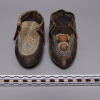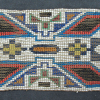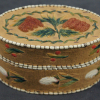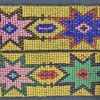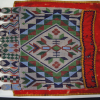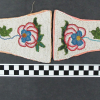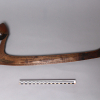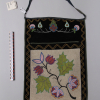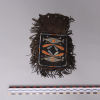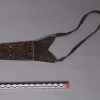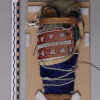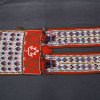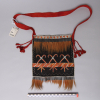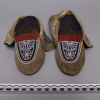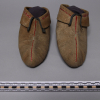Relatives/Heritage items
Displaying 1181 - 1200 of 4694 Relatives
Browsing allows you to see all the records for relatives and heritage items in the GKS. You can also search by material made, and/or filter by nations. To search by material made, type the material's name, by example 'leather', in the box below and click “Apply.” You can select multiple nations from the dropdown list by pressing “Ctrl” (on PC) or “Command” (on Mac) and clicking, then select “Apply.”
Huron-Wendat moccasins made of blackened hide decorated with moosehair embroidery in floral motifs, made between 1810-1830. On one moccasin, a lighter hide is used for the U-shaped vamp. Documented as a pair but both sides are very different. Purchased from Professor Moseley in 1882.
This bandolier bag was made with stroud, cotton, and has loom woven beadwork. It has repetitive arrows and rectangles layered in the beads in white, black, greasy green, greasy rose, and navy. This bag appears to be Anishinaabe from the Central Great Lakes 1860s-1870s. It
This item is an unfinished pair of garters that was heddle woven and tied together by the linen warp threads. Outer ends were braided into tassels with the addition of woolen yarn. Symmetrical designs of X-shapes with diamond in the middle, otter tails, triangles, and
This box is made of Birch bark and moose hair embroidery with natural colors, green, brown, red, yellow, and pink creating a floral design. It was likely made in the 19th or early 20th c. by someone of the Huron in the Great Lakes region
This necklace was heddle woven with linen thread and seed beads of yellow, black, shades of blue, greens, opaque brown, red, and dusty rose. Tabs were beaded and finished with red yarn. Pinwheel/eight-pointed star and nested lozenge designs were created with alternating colors. Necklace was
This bandolier bag was hand sewn with American made red twill blanketing, Calico, and beadwork that was loomwoven. Bead colors include white, transparent burgundy, opaque sky blue and navy, transparent dark green, opaque medium green. Design has zig zag, radiating diamonds, stepped triangles, and ottertails
This belt was made from wool, linen, and beads loom-woven with white background, black, light turquoise, navy, shades of green (2), transparent red, transparent gold. Designs were created with diamond and rectangle patterns. Item comes from the Great Lakes area and was donated by Mrs
This two-piece belt was hand sewn using silk, cotton, beads, and metal hooks and eyes. Applique beadwork was done with shades of blue (3), shades of green (2) both transparent, yellow, gold, dusty rose, color-lined red, brown to create floral motifs. Item is from the
This miniature canoe was made of Birch bark, stitched with cotton thread and split spruce root, and embellished with a floral design by using natural and faded green, red, purple quills. Item is likely from the 19th or very early 20th century, created by Anishinaabe
Anishinaabe wooden club with animal being with open mouth holding a pointed ball-head. Elaborately carved and painted and dyed on both sides. Made between 1800-1850. Purchased through the Venduehuis der Notarissen auction house in The Hague in 1898.
Anishinaabe bag with bandolier pouch construction, made of black velvet with beaded front panel in floral motifs and a cotton tape handle. Made between 1890-1900. Purchased by Ted Brasser from Mr. Pommerehnke in Calgary in 1969, who collected the bag in Vancouver in the same
A pouch made of blackened hide with drawstring construction and two panels decorated with porcupine quills. Possibly Penobscot or Abenaki, made between 1800-1880. Purchased by the museum from Professor Moseley in 1882.
Pouch made of furred hide with a scalloped edge flap of blackened deerskin decorated with three pairs of quilled horn motifs, and a quilled strap with metal cone ends and a central woven beadwork panel. Possibly Anishinaabe(?), made between 1775-1800. Transferred to the museum from
A seventeenth century Hodenosaunee ball-headed club with single line engravings and notched triangular motifs on one side. Transferred to the museum from the Koninklijk Kabinet van Zeldzaamheden (The Royal Cabinet of Curiosities) in The Hague when it closed in 1883.
A knife sheath made of blackened hide decorated with a row of small metal cones with animal hair and porcupine quills in geometric motifs. Attributed to the Menomini, made between 1820-1850. Purchased by the museum from A. Hakbijl in 1868.
A Hodenosaunee model wooden cradleboard and doll with beaded ribbon wrappings. Seneca, made ca. 1880. Collected by Herman ten Kate and acquired by the museum in 1889.
This bandolier bag was made with red twill wool, painted calico, cream muslin lining, glass and lead beads. Techniques include loom woven beadwork, two-needle open applique, machine stitching, and hand stitching. Geometric designs include hourglass, diamond, maple leaf, five-pointed stars, and otter-tail borders in reddish
Pouch made of blackened hide with yarn strap, decorated with metal cones with dyed animal hair and quillwork appliqué in three central repeated motifs, possibly representing thunderbirds(?). Dated at 1800-1850, yarn strap with tassels possibly added later(?). Acquired by the museum through auction in 1892.
A pair of hide moccasins with red stroud vamps decorated with beadwork in floral motifs, made between 1830-1865. Purchased by the museum from A. Hakbijl in 1868.
A pair of moccasins with central seam, made ca. 1840. Decorated with porcupine quills on the seams and cuffs, a pair of horn or hook motifs stitched in the middle of the moccasin top. Gifted to the museum by K. Hoogeveen in 1884.
 Knowledge Sharing Platform
Knowledge Sharing Platform

